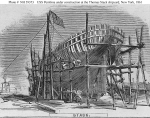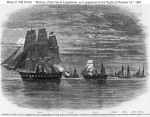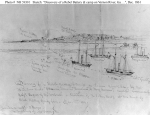Specifications:
Displacement 507 t.
Length 171'
Beam 31' 6"
Depth 15' 9"
Draft 10'
Speed 10 kts
Complement unknown
| Click On Image For Full Size Image |
Size | Image Description | ||
|---|---|---|---|---|
 |
198k | Line engraving published in "Harper's Weekly", July-December 1861, depicting Pembina under construction at the Thomas
Stack shipyard, New York City. Pembina was launched on 28 August 1861. US Naval History and Heritage Command photo # NH 59373 |
US Naval History and Heritage Command | |
 |
82k | Line engraving published in Harper's Weekly, July-December 1861 volume. depicting the ten "90-Day Gunboats" constructed for the U.S. Navy in
1861-62. Ships, as identified in the image are from left to right;
USS Chippewa USS Sciota USS Itasca USS Winona USS Huron USS Ottawa USS Pembina USS Seneca USS Unadilla and USS Sagamore. U.S. Naval Historical Center Photograph. Photo #: NH 59367 |
Robert Hurst | |
 |
170k | "Portion of the Naval Expedition, as it appeared on the night of October 16, sailing to Hampton Roads. -- Sketched by an Officer on Board. 1861". Line engraving published in "Harper's Weekly", July-December 1861 volume, pages 712. It depicts Flag Officer DuPont's squadron en route to capture Port Royal, South Carolina. Ships, all U.S. Navy, as identified below the image bottom, are (from left): USS Wabash, USS Florida, USS Augusta,, USS Alabama,, USS Ottawa,, USS Seneca, and USS Pembina. US Naval History and Heritage Command photo # NH 59316 |
Robert Hurst | |
 |
100k | "The Great Naval Expedition" to capture Port Royal, South Carolina, November 1861. Engraving published in "Harper's Weekly", July-December
1861 volume, pages 696-697, depicts Federal warships and transports, under Flag Officer Samuel F. DuPont, USN, departing Hampton Roads, Virginia, en route to Port
Royal. Ships, as identified below the image bottom, are (from left): (illegible), Oriental, Baltic, USS O.M. Pettit, USS Gem of the Sea, Great Republic, USS Wabash (DuPont's flagship), USS Seneca, USS Pembina, USS Connecticut, USS Mercury, USS Unadilla, USS Augusta, USS Alabama and (illegible). US Naval History and Heritage Command Photo #: NH 59315 |
Robert Hurst | |
 |
105k | "Reconnaissance of Vernon River, Ossabaw Sound, Georgia, Discovery of a Rebel Battery and Camp, 11 December 1861". Line engraving published in Harper's Weekly, January 1862. It depicts Federal warships engaging the Confederate battery, shown in the far left distance. Ships, as identified below the image bottom, are (from left): USS Seneca, USS Pembina, USS Ottawa and Steamer Mary Andrew. For the original sketch from which this engraving was made, see Photo # NH 59310. US Naval Historical Center Photo #: NH 59309 |
Robert Hurst | |
 |
96k | "Discovery of a Rebel Battery and Camp on Vernon River, Georgia, 11 December 1861". Sketch by William Crane, artist for Harper's Weekly, presented by the artist to LT, Thomas H. Stevens, Commanding Officer of USS Ottawa. It depicts the US Navy gunboats USS Seneca, USS Pembina, USS Ottawa and steamer Mary Andrew, at the time of Rebel Battery opening fire. The Federal ships were under the command of CDR. C.R.P. Rodgers of USS Wabash. This sketch apparently served as the basis for the engraving seen in Photo # NH 59309. |
Robert Hurst | |
 |
78k | "Army & Navy Reconnaissance. Tuesday Morning Nov. 5" 1861
Line engraving published in "The Soldier in Our Civil War", Volume I, page 189, depicting Federal ships investigating Port Royal Sound, South Carolina, prior to their successful attack on Confederate fortifications there.
Ships and other items identified across the bottom of the print include (from left to right): USS Mercury, with Generals Sherman and Stevens & staff on board; USS Penguin, with Hilton Head Battery beyond; USS Pawnee; Broad River (in distance); CSS Huntress (distance); USS Seneca; Steamer Screamer (distance); USS Ottawa with Capt. Rogers & General Wright on board; Steamer Everglades (distance, beyond Ottawa; USS Pembina; CSS Lady Davis (distance); Beaufort River (distance); Bay Point Battery (distance); USS Curlew; (probably misidentified as no record exists that USS Curlew served with South Atlantic Blockading Squadron) Confederate camp (distance); USS Isaac Smith. US Navy photo # NH 59319 |
Tommy Trampp | |
 |
75k | "Bombardment and Capture of Port Royal, South Carolina, 7 November 1861"
Engraving published in "Harper's Weekly", July-December 1861 volume, pages 760-761.
It depicts Federal warships, under Flag Officer Samuel F. DuPont, USN, bombarding Fort Beauregard (at right) and Fort Walker (at left). The Confederate squadron commanded by Commodore Josiah Tattnall is in the left center distance.
Subjects identified below the image bottom are (from left):
tug Mercury, Fort Walker, USS Wabash (DuPont's flagship), steamer Screamer (?), USS Susquehanna, CSS Huntsville, Commo. Tattnall, (probably misidentified as no record exists that CSS Huntsville served in the defenses of Port Royal, S.C. USS Bienville, USS Pembina, USS Seneca, USS Ottawa, USS Unadilla, USS Pawnee, USS Mohican, USS Isaac Smith, USS Curlew; (probably misidentified as no record exists that USS Curlew served with South Atlantic Blockading Squadron), USS Vandalia, USS Penguin, USS Pocahontas, USS Seminole, Fort Beauregard, USS R.B. Forbes and "Rebel Camp". US Navy photo # NH 59256 |
US Naval History and Heritage Command | |
 |
116k | "Gun-Boats Entering Savannah River above Fort Pulaski." Engraving published in Harper's Weekly, January-June 1862 volume, page 132. It
depicts USS Pembina (left center) and USS Unadilla (right) engaging Confederate gunboats under Commodore Josiah
Tattnall while entering the Savannah River, Georgia, to cut off Fort Pulaski, 22 February 1862. US Naval History and Heritage Command photo # NH 59284 |
US Naval History and Heritage Command | |
USS Pembina (I)
Dictionary of American Naval Fighting Ships (DANFS)
| Back To The Navsource Photo Archives Main Page | Back To The Old Navy" Steam and Sail Index |
| Comments, Suggestions, E-mail Webmaster. |
|
This page is created and maintained by Gary P. Priolo |